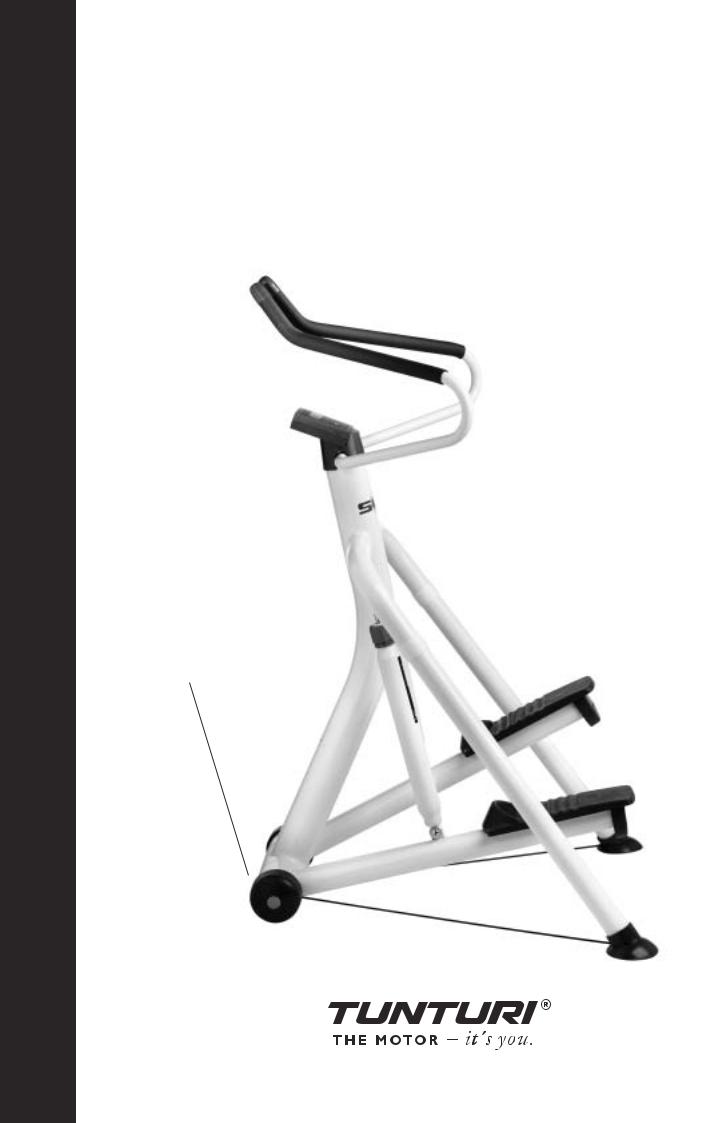Tunturi S30 User Manual

S30
•SERIAL NUMBER • SERIENNUMMER
•NUMERO DE SERIE • NÚMERO DE SERIE
•NUMERO DI SERIE • SERIENUMMER
•SERIENNUMMER • SARJANUMERO
OWNERíS MANUAL |
P. |
2 |
- 5 |
|
|
|
|
BETRIEBSANLEITUNG |
S. |
6 |
- 10 |
|
|
|
|
MODE DíEMPLOI |
P. |
11 |
- 14 |
|
|
|
|
HANDLEIDING |
P. |
15 |
- 18 |
|
|
||
MANUALE DíUSO |
P. 19 - 22 |
||
|
|
||
MANUAL DEL USUARIO |
P. 23 - 26 |
||
|
|
||
BRUKSANVISNING |
S. 27 - 30 |
||
|
|
||
KƒYTT÷OHJE |
S. 31 - 34 |
||
|
|
|
|
www.tunturi.com

O W N E R í S M A N U A L ï S 3 0
INFORMATION AND WARNINGS
Read this guide through carefully before assembling, using or servicing your fitness equipment. Please keep the guide somewhere safe; it will provide you now and in the future with the information you need to use and maintain your equipment. Always follow these instructions with care.
The equipment has been designed for home use. The Tunturi warranty applies only to faults and malfunctions in home use (24 months). Please note that the warranty does not cover damage due to shipping or negligence of assembly, use, adjustment or maintenance instructions described in this manual. Changes or modifications not expressly approved
by Tunturi Oy Ltd will void the user’s authority to operate the equipment!
NOTE ABOUT YOUR HEALTH
•Before you start any training, consult a physician to check your state of health.
•If you experience nausea, dizziness or other abnormal symptoms while exercising, stop your workout at once and consult a physician.
•To avoid muscular pain and strain, begin each workout by warming up and end it by cooling down. Don’t forget to stretch at the end of the workout.
NOTE ABOUT THE EXERCISING ENVIRONMENT
•The equipment is not to be used outdoors.
•Place the equipment on a firm, level surface. Place the equipment on a protective base to avoid any damages to the floor beneath the equipment.
•Make sure that the exercising environment has adequate ventilation. To avoid catching cold, do not exercise in a draughty place.
•In training, the equipment tolerates an environment measuring +10°C to +35°C. The equipment can be stored in temperatures ranging between -15°C
and +40°C. Air humidity in the training or storage environment must never exceed 90 %.
NOTE ABOUT USING THE EQUIPMENT
•If children are allowed to use the equipment, they should be supervised and taught to use the equipment properly, keeping in mind the child’s physical and mental development and their personality.
•Before you start using the equipment, make sure that it functions correctly
in every way. Do not use a faulty equipment.
•Press the keys with the tip of the finger; your nails may damage the key membrane.
•Never lean on the interface.
•Only one person may use the equipment at a time.
•Hold the handlebar for support when getting on or off the equipment. Keep at least one hand on the handlebar when exercising.
•Wear appropriate clothing and shoes when exercising.
•Protect the meter from sunlight and always dry the surface of the meter if there are any drops of sweat on it.
•The equipment must not be used by persons weighing over 100 kg.
•Do not attempt any servicing or adjustments other than those described in this guide. The given service instructions must be followed carefully.
SAVE THIS INSTRUCTION MANUAL
WELCOME TO THE WORLD OF
TUNTURI EXERCISING!
Your choice shows that you really want to invest in your well being and condition; it also shows you really value high quality and style. With Tunturi Fitness Equipment, youíve chosen a high quality, safe and motivating product as your
2

training partner. Whatever your goal in training, we are certain this is the training equipment
to get you there. Youíll find information about using your exercise equipment and what makes for efficient training at Tunturiís website at
WWW.TUNTURI.COM.
ASSEMBLY
Unpack the device and check that all the following parts are in the package (fig. 1):
A. Main mast assembly
B. Leg tubes (2)
C.Tie rods (2)
D.Feet (2)
E. Handlebar
F. Meter mount
G. Meter
H. Shocks (2)
Assembly kit (contents marked with in the spare part list): keep the assembly tools, as you
may need them e.g. for adjusting the equipment.
If you notice that a part is missing, contact the dealer and give the model (S30), serial number and spare part number from the list at the back of the manual. The assembly figures mentioned in the text are at the back of the manual. The package includes a silicate bag for absorbing moisture during storage and transportation. Assemble the device as follows (left, right, front and back are as seen from the exercising position):
ATTACH THE LEGS
Position the main mast assembly so that the S30 label is facing up. Screw the left leg tube
into the main mast as shown, being careful to keep the leg tube in line (fig. 2). NOTE! Do not force. If resistance is felt initially, unscrew and start again. Hand tighten the leg firmly. Attach the right leg in the same manner.
ATTACH THE TIE RODS
Place the hooked end of a tie rod into the left hole on the bottom of the main mast (fig. 3). Gently slide the tie rod bracket into the end of the left tube while simultaneously inserting the threaded end of the tie rod into the tie rod bracket. Slide the bracket with the rod into the
tube as far as possible, making sure the bracket is at right angle to the tie rod. Secure the tie
O W N E R í S M A N U A L ï S 3 0 GB
rod with a 5 mm flat washer and a locking nut. Tighten the nut with the enclosed flat wrench (fig. 4). Repeat for the right tie rod.
ATTACH THE FEET
The feet are labeled ìLîand ìRî (for left and right). Slide each foot onto its respective leg, making sure the tie rod connects at the bottom of the slot (fig. 4). At this time, tilt the unit back onto the feet.
INSTALL THE SHOCKS
Attach the end of the shock absorber that contains the resistance adjustment mechanism to the left side of the main mast. Insert a shock spacer into the eye of the top end of the shock. With the arrow facing to the rear, secure the shock to the outside of the top, left mounting bracket with a socket head cap screw, two 8 mm flat washers, and a locking nut. Use the flat wrench and the 5 mm hex wrench to tighten. Lift the left foot pedal up and secure the bottom of the shock repeating the same steps as for the upper shock attachment (fig. 5). Install the right shock in the same manner.
ATTACH THE HANDLEBAR
Align the holes on the base of the handlebar to those on the top of the mast, making sure the handlebar end caps are pointing forward. Secure the handlebar with four Allen screws and 6 mm split lock washers (fig. 6). Tighten screws with the 5 mm hex wrench.
ATTACH THE METER
Open the battery case cover on the back of the meter case and insert two 1.5 V AA-batteries to the battery case following the + and - markings. Feed the meter wire, coming out through the top of the vertical frame, through the meter mount and snap the meter mount over the handlebars, making sure the tongue on the handlebar mount aligns with the corresponding groove on the meter mount (fig. 7). NOTE! Be careful not to get the wire caught! Plug the meter cable into the socket on the rear of the meter. Secure the
meter into place by setting it on the meter mount and sliding it down until firmly in place. NOTE! Make sure the meter cable is not pinched during the assembly as this can cause the meter to not function correctly (fig. 8).
3

O W N E R í S M A N U A L ï S 3 0
USE
Resistance is adjusted by turning the adjustment ring located on the hydraulic cylinders (12 different resistance levels). The arrow on the shock indicates the chosen resistance level.
Start with slow tempo, long step height and low resistance. Gradually increase tempo and resistance and shorten step height according to your own condition. Keep your head up and
neck long in order to avoid stress on your neck, shoulders and back. Keep also your back straight. Make sure, that your feet are centered on the foot pedals and that your hips, knees, ankles and toes are facing forward. Keep your body weight centered over your lower body regardless of whether you lean forward or stand upright. By shifting your weight forward or back you can concentrate the workout toward different lower body muscles. Stop your workout by gradually decreasing tempo and resistance. Lengthen your step height until your heart rate has returned to normal. Donít forget to stretch afterwards.
To strengthen cardiovascular system, maintain low resistance, but high tempo. Exercising with higher resistance and slow tempo strengthens correspondingly your back and hips.
METER
KEYS
ON/OFF
Switches power on and off. When you switch on the meter, it displays the time and begins countup automatically.
SELECT
Alternates modes and displays.
FUNCTIONS
TIME
(Clock symbol) Time count-up (00:00-).
RATE
(Rabbit symbol) Steps/min.
STEPS
(Stairway symbol) Step count-up (000.0-).
TOTAL STEPS
(Mountain symbol) Shows the total steps on the climber in thousands (1000 = 1). Total steps can be reset to zero by pressing the small reset key in the bottom of the meter.
KCAL
(Hamburger symbol) Estimated energy consumption at 7/16 kcal per step.
PULSE
(Heart symbol) Heart rate measurement (40 - 240).
TELEMETRIC HEART RATE
MEASUREMENT
The S30 is fitted with an internal heart rate receiver to make them compatible with Polar telemetric heart rate transmitters. The transmitter may be purchased as an accessory. Exercise within different heart rate ranges affects the body in different ways. For example, exercise of long duration within a heart rate range that is about 50-60 % of the maximum heart rate burns fat,
or helps you lose weight, whereas exercise in a range that is about 70-80 % of the maximum develops the heart and respiratory system, and overall endurance, i.e. it improves your condition.
If you donít know your own maximum heart rate you can use the following formula as a guide:
208 ñ 0,7 X AGE
However, it is advisable to make sure by consulting your doctor.
The most reliable heart rate measurement is achieved with a telemetric device, in which the electrodes of the transmitter fastened to the chest transmit the pulses from the heart to the meter by means of an electromagnetic field.
NOTE! If you have a heart pacemaker, you may use the heart rate measurement transmitter only on a physicianís approval!
If you want to measure your heart rate this way during your workout, moisten the grooved electrodes on the transmitter belt with saliva or
water. Fasten the transmitter just below the chest with the elastic belt, firmly enough so that the electrodes remain in contact with the skin, but not so tight that normal breathing is prevented. The transmitter automatically transmits the heart rate reading to the meter up to a distance of about 1 m. If you wear the transmitter and belt over a light shirt, moisten the shirt slightly at the points where the electrodes touch the shirt.
4

MAINTENANCE
The S30 requires very little maintenance. Check, however, from time to time that all screws and nuts are tight, and apply light grease or vaseline to the pivot points of the shocks if necessary. Clean the climber from dirt and dust with a damp cloth or towel. Do not use solvents.
If the device is not functioning properly during use, contact your Tunturi dealer immediately. Always give the model (S30) and the serial number of your device.
Despite continuous quality control, faults or malfunctions due to individual components may arise. It is, however, unnecessary to send the whole device to be repaired as the fault can
in most cases be repaired by replacing the component in question.
CHANGING THE BATTERIES
If the meter display becomes very weak or there is no display at all, change the batteries. Remove the meter from its mount on top of the main mast. Open the battery cover on the back of the meter case and remove the old batteries. Insert new batteries (two 1.5 V AA-batteries) to the battery case following the + and - markings.
Push the battery case cover back into place. Slide the meter onto its mounting on top of the vertical frame.
MOVING AND STORAGE
The stepper is easy to move by pushing along on the integrated transport wheels. Tilt the stepper from the front and push along the floor on the wheels at the bottom of the main mast.
Place the equipment on a firm, level surface, and on a protective base to avoid any damages to the floor beneath the equipment. Notice that certain floor materials may require protection when transporting the equipment.
To prevent malfunctioning, store the stepper in a dry space with as little temperature variation as possible, protected from dust.
|
O W N E R í S M A N U A L ï S 3 0 |
GB |
|
|
|
||
|
|
||
|
|
|
|
DIMENSIONS |
|
|
|
Length |
87 cm |
||
Height |
141 cm |
||
Width |
86 cm |
||
Weight |
32 kg |
||
This product carries the CE label.
All Tunturi steppers meet EN precision and safety standards (EN-957, parts 1 and 8).
Due to our continuous policy of product development, Tunturi reserves the right to change specifications without notice.
5

B E T R I E B S A N L E I T U N G ï S 3 0
WICHTIGE SICHERHEITSHINWEISE
Dieses Handbuch ist ein wesentlicher Bestandteil Ihrer Trainingsausrüstung. Lesen Sie dieses Handbuch bitte sorgfältig durch, bevor Sie Ihr Trainingsgerät montieren, mit ihm trainieren oder es warten. Bitte bewahren Sie dieses Handbuch; es wird Sie jetzt und zukünftig darüber informieren, wie Sie Ihr Gerät benutzen und warten. Befolgen Sie diese Anweisungen immer sorgfältig.
Ihr neuer Heimtrainer von Tunturi wurde für das Heimtraining entwickelt. Die Garantie dieses Gerätes beträgt 24 Monate für das Heimtraining. Sowohl Tunturi, als auch seine nationalen Vertretungen übernehmen keine Haftung für Verletzungen oder Geräteschäden, die sich bei Einsatz in gewerblichen Fitnesscentern, Sportvereinen und vergleichbaren Einrichtungen ergeben. Die Garantie schliesst keine Beschädigungen
ein, die auf Fahrlässigkeit bei der Montage, Einstellung und Wartung, wie sie in diesem Handbuch beschrieben wurden, zurückzuführen sind. Werden Modifizierungen ohne das Einverständnis der Tunturi Oy Ltd vorgenommen, erlischt jeglicher Garantieanspruch!
BITTE BEACHTEN:
•Vor Beginn eines Trainingsprogrammes einen Arzt konsultieren.
•Bei Übelkeit, Schwindelgefühl oder anderen anomalen Symptomen sollte das Training sofort abgebrochen und unverzüglich ein Arzt aufgesucht werden.
•Aufgrund des natürlichen Spieltriebes und der Experimentierfreudigkeit
der Kinder können Situationen und Verhaltensweisen entstehen, für die das Trainingsgerät weder gebaut noch abgesichert ist und die eine Verantwortung seitens des Herstellers ausschliessen. Wenn Sie dennoch
Kinder an das Trainingsgerät lassen, müssen Sie deshalb deren geistige und
körperliche Entwicklung und vor allem deren Temperament berücksichtigen, sie gegebenenfalls beaufsichtigen und sie vor allem auf die richtige Benutzung des Gerätes hinweisen.
•Das Gerät darf nur von einer Person benutzt werden.
•Das Gerät daft nur in Innenräumen benutzt werden. Sorgen Sie dafür, dass der Trainingsraum gut belüftet ist. Vermeiden Sie doch Zugluft.
•Das Gerät auf möglichst ebenen Untergrund stellen. Es wird empfohlen, das Gerät auf eine Schutzmatte zu stellen.
•Stützen Sie sich nie gegen das Benutzerinterface ab!
•Bedienen Sie die Tasten mit der Fingerkuppe. Ein Fingernagel kann die Membrane der Tasten beschädigen.
•Dieses Gerät ist nicht für den Einsatz in Feuchträumen (Sauna, Schwimmbad) vorgesehen.
•Beim Training muss die Umgebungstemperatur zwischen +10°C und +35°C liegen. Zur Aufbewahrung kann das Gerät bei Temperaturen zwischen -15°C und +40°C gelagert werden. Die Luftfeuchtigkeit darf nie 90 % überschreiten.
Um eine Beschädigung der Flüssigkristallanzeige zu vermeiden, das Gerät vor direkter Sonnenbestrahlung sowie vor starken Stössen und Schlägen schützen. Sicherstellen, dass die Elektronikanzeige nicht mit Wasser in Berührung kommt.
•Vor Beginn des Trainings sicherstellen, dass das Gerät völlig intakt ist. Auf keinen Fall mit einem fehlerhaften Gerät trainieren.
•Zum Auf-und Absteigen am Lenker abstützen. Während des Trainings sich mindestens mit einer Hand an der Handstütze abstützen.
6

•Zur Benutzung des Gerätes stets angemessene Kleidung und Schuhwerk tragen.
•Nie die Hände in die Nähe von beweglichen Teilen bringen.
•Zur Vermeidung von Muskelkater Aufund Abwärmtraining nicht vergessen.
•Keine anderen als die in dieser Betriebsanleitung beschriebenen Wartungsmassnahmen und Einstellungen vornehmen. Die angegebenen Wartungsanweisungen sind einzuhalten.
•Das Gerät darf nicht von Personen benutzt werden, deren Gewicht über 100 kg liegt.
HERZLICH WILLKOMMEN
IN DER WELT DES TRAINIERENS
MIT TUNTURI!
Durch Ihren Kauf haben Sie bewiesen, dass Ihnen Ihre Gesundheit und Ihre Kondition viel wert sind; auch haben Sie gezeigt, dass Sie Qualit‰t zu sch‰tzen wissen. Mit einem TunturiFitnessger‰t haben Sie sich f¸r ein hochwertiges, sicheres und motivierendes Produkt als Trainingspartner entschieden. Welches Ziel Sie auch immer mit Ihrem Training verfolgen, wir sind sicher, dass Sie es mit diesem Fitnessger‰t erreichen. Hinweise zu Ihrem Trainingsger‰t und zum effektiven Training damit finden Sie auf der Internetseite von Tunturi WWW.TUNTURI.COM.
MONTAGE
Alle Teile auspacken. Sicherstellen, dass folgende Teile geliefert wurden (Abb. 1):
A. Hauptprofil
B. St¸tzbeine (2)
C. Streben (2)
D. Bodenschoner (2)
E.Handst¸tze
F.Anzeigenhalterung
G.Elektronikanzeige
H.Hydraulikzylinder (2)
Werkzeugset (der Inhalt steht mit * auf der Ersatzteilliste): bewahren Sie die Werkzeuge sorgf‰ltig auf, denn Sie kˆnnen sie sp‰ter u.a. zur Justierung benˆtigen.
B E T R I E B S A N L E I T U N G ï |
S 3 0 |
D |
|
||
|
Sollte irgendein Teil des Ger‰tes fehlen, Kontakt mit Ihrem Tunturi-Fachh‰ndler aufnehmen und die Modellbezeichnung des Ger‰tes (S30), die Seriennummer und die Ersatzteilnummer des fehlenden Teiles (s. nachstehende Ersatzteilliste) angeben. Die im Text angegebenen Abbildungen befinden sich am Ende dieser Gebrauchsanleitung. Der beiliegende Beutel mit Granulat dient als Klimaschutz w‰hrend des Transportes und sollte nach Montage beseitigt werden. Die Beschreibung der Lage von Teilen (rechts, links, vorne, hinten) geht von der Blickrichtung beim Training aus. Das Ger‰t wie folgt zusammenbauen:
MONTAGE DER ST‹TZBEINE
Das Hauptprofil so auf den Boden legen, dass das S30-Etikett nach oben zeigt. Das linke St¸tzbein durch Drehen im Uhrzeigersinn an das Hauptprofil montieren (Abb. 2).
Bei der Montage keine Gewalt anwenden. Wenn das Gewinde nicht richtig fasst, St¸tzbein wieder herausdrehen und neu ansetzen. Das St¸tzbein solange festdrehen, bis es fest mit dem Hauptprofil verbunden ist. Danach das rechte St¸tzbein entsprechend montieren.
MONTAGE DER STREBEN
Den am Ende der Strebe befindlichen Haken in die linke Bohrung unten am Hauptprofil einh‰ngen (Abb. 3). Das Befestigungsblech auf das Strebenende mit dem Gewinde stecken. Das Befestigungsblech vorsichtig so tief wie mˆglich in das St¸tzbein stecken. Sicherstellen,
dass das Befestigungsblech im richtigen Winkel zur Strebe sitzt. Die Strebe mit der 5 mm Unterlegscheibe und M5 Mutter sichern. Dazu den mitgelieferten Schl¸ssel benutzen (Abb. 4). Danach die rechte Strebe entsprechend montieren.
MONTAGE DER BODENSCHONER
Die Bodenschoner sind mit R und L markiert (L = links, R = rechts). Den linken Bodenschoner so auf das St¸tzbein setzen, dass die Strebe in seine Einkerbung gelangt (Abb. 4). Danach den rechten Bodenschoner entsprechend montieren.
MONTAGE DER HYDRAULIKZYLINDER
Den linken Hydraulikzylinder so auf der linken Seite des Hauptprofils anbringen, dass der Einstellmechanismus nach oben kommt und die Pfeilmarkierung zum Trainierenden zeigt. Dazu die H¸lse in die obere Befestigungsˆse des Hydraulikzylinders stecken und den
7

B E T R I E B S A N L E I T U N G ï S 3 0
Hydraulikzylinder von aussen an die Halterung am St¸tzbein montieren und mit der M8-
1,25 x 40 mm Schraube, zwei 8mm Unterlegscheiben und einer M8 Sicherungsmutter sichern sowie mit Hilfe des 5 mm Inbusschl¸ssels und des Gabelschl¸ssels festziehen. Das linke Pedal anheben und
den Hydraulikzylinder wie am oberen Ende einh‰ngen und befestigen (Abb. 5). Den rechten Hydraulikzylinder entsprechend befestigen.
MONTAGE DER HANDST‹TZE
Das Handst¸tzenrohr so in das obere Ende des Hauptprofils stecken, dass die Handst¸tzenenden nach vorne zeigen und die Bohrungen in der Mitte des Handst¸tzenrohrs und am Hauptprofil ¸bereinander gelangen. Die Handst¸tze mit vier Inbusschrauben und 6 mm Unterlegscheiben mit Hilfe des mitgelieferten 5 mm Inbusschl¸ssels befestigen (Abb. 6).
MONTAGE DER ELEKTRONIKANZEIGE
Deckel des Batteriefachs an der R¸ckseite der Elektronikanzeige ˆffnen und die Batterien (2 x 1,5 V AA) unter Ber¸cksichtigung der Polarit‰t (+/-) einsetzen. Das vom Hauptprofil kommende Kabel durch die Bohrung an der Elektronikanzei genhalterung stecken und die Elektronikanzeige so auf das Hauptprofil stecken, dass die Nase an der Handst¸tzenbefestigung auf die Einkerbung an der Elektronikanzeigenhalterung gelangt (Abb. 7). BITTE BEACHTEN! Darauf achten, dass das Elektronikanzeigenkabel nicht eingeklemmt wird. Das vom Hauptprofil kommende Kabel
in die Buchse am Boden der Elektronikanzeige einstecken. Die Elektronikanzeige in die Halterung am Hauptprofil
stecken (Abb. 8). BITTE BEACHTEN! Darauf achten, dass das Elektronikanzeigenkabel
nicht eingeklemmt wird.
BETRIEB
Der Trainingswiderstand wird mit Hilfe des am Hydraulikzylinder befindlichen Einstellrings (12 Stufen) geregelt. Der Pfeil am Hydraulikzylinder zeigt auf den jeweils eingestellten Trainingswiderstand.
Mit ruhiger Steigbewegung bei grosser Tritthˆhe und geringem Trainingswiderstand beginnen. Je nach Kondition das Tempo und den Trainingswiderstand langsam erhˆhen und die Tritthˆhe reduzieren. Dabei den Kopf hoch
und Nacken und R¸cken gerade halten, damit Nacken, Schultern und R¸cken nicht zu stark belastet werden. Sicherstellen, dass sich die F¸sse etwa in der Mitte des Fussauflage befinden und H¸fte, Knie, Fussgelenke und Zehen
nach vorne zeigen. Den Kˆrperschwerpunkt, unabh‰ngig davon, ob der Kˆrper leicht nach vorne geneigt ist oder nicht, immer auf die unteren Gliedmassen verlagern. Durch Neigung nach vorne oder hinten kˆnnen verschiedene Beinmuskelgruppen trainiert werden. Gegen Trainingsende zum Abw‰rmen Tempo und Widerstand langsam reduzieren und Tritthˆhe vergrˆssern, bis der Puls seinen Normalwert erreicht hat. Zum Schluss die Gliedmassen dehnen.
Um das Herz-Kreislaufsystem zu trainieren, mit geringem Trainingswiderstand und hohem Tempo arbeiten. Ein Training mit hohem Trainingswiderstand und geringerem Tempo st‰rkt den R¸cken und die H¸ften.
ELEKTRONIKANZEIGE
TASTEN
ON/OFF
Ein-/Austaste. Nach dem Einschalten der Elektronikanzeige beginnt automatisch die Trainingszeitmessung zu laufen (00:00).
SELECT
Zum Aufrufen der verschiedenen Funktionen.
FUNKTIONEN
TIME
(Zeit, Uhrsymbol) Absolvierte Trainingszeit (00: 00 -)
RATE
(Tempo, Hasensymbol) Treppenstufen pro Minute
STEPS
(Gestiegene Treppenstufen, Treppensymbol)
Kumulative Treppenstufen (0000 -)
TOTAL STEPS
(Insgesamt gestiegenen Treppenstufenzahl, Bergsymbol) Insgesamt gestiegene Treppenstufenzahl in 1000 Stufen (z. B: 1000 Treppenstufen = 1). Zum
Zur¸cksetzen der insgesamt gestiegenen Treppenstufenzahl die kleine Reset-Taste am Boden des Elektronikanzeige dr¸cken.
8

KCAL
(Energieverbrauch, Hamburgersymbol) Gesch‰tzter Kalorienverbrauch, 7/16 kcal/ Treppenstufe
PULSE
(Herzfrequenz, Herzsymbol) Gemessene
Herzfrequenz (40 - 240).
DRAHTLOSE MESSUNG
DER HERZFREQUENZ
Der Empf‰nger in der Elektronikanzeige ist kompatibel mit den meisten drahtlosen Herzfrequenzmessger‰ten von Polar (Zusatzausr¸stung). Ein Training bei
verschiedenen Herzfrequenzen hat verschiedene Wirkungen auf den Organismus. Z. B. ein langes Trainieren bei einer Pulsfrequenz, die 50ñ60 % des max. Wertes betr‰gt, beschleunigt den Fettstoffwechsel, d. h. macht schlank. Ein Training bei einer Herzfrequenz, die 70 - 80 % des max. Wertes betr‰gt, st‰rkt das Herz, die Atemorgane und die allgemeine Ausdauer,
d. h. verbessert die Kondition. Ist Ihnen Ihr Maximalherzfrequenz nicht bekannt, kˆnnen Sie die folgende Formel zur ungef‰hren Berechnung verwenden:
208 - 0,7 X ALTER
Es wird jedoch empfohlen, immer einen Arzt zu konsultieren.
Als zuverl‰ssigste Art der Messung der Herzfrequenz hat sich die drahtlose
Herzfrequenzabnahme erwiesen, bei der die Herzschl‰ge mit einem Elektrodengurt von der Brust abgenommen werden. Vom Gurt werden die Impulse danach ¸ber ein elektromagnetisches Feld an den Empf‰nger in der Elektronikanzeige ¸bertragen.
BITTE BEACHTEN! Falls Sie einen
Herzschrittmacher haben, d¸rfen Sie den Herzfrequenzsender nur mit einem artzlichen Gutachten verwenden!
Zur drahtlosen Herzfrequenzmessung w‰hrend des Trainings die an der Haut anliegenden Elektroden am Elektrodengurt sorgf‰ltig
mit Wasser oder Speichel anfeuchten. Den Sender mit Hilfe des Gurtes fest unterhalb der Brustmuskulatur befestigen und darauf achten, dass der Gurt beim Training nicht verrutscht. Den
B E T R I E B S A N L E I T U N G ï |
S 3 0 |
E4RD |
|
||
|
Elektrodengurt jedoch nicht so festziehen, dass z. B. die Atmung erschwert wird. Der Sender kann den Herzfrequenzwert bis zu einer Entfernung von zirka 1 m an den Empf‰nger ¸bertragen. Wird der Elektrodengurt ¸ber einem d¸nnen Hemd getragen, sind die gegen die Elektroden gerichteten Fl‰chen ebenfalls zu befeuchten.
WARTUNG
Der S30 ist weitgehend wartungsfrei. Dennoch sind von Zeit zu Zeit Schrauben und Muttern auf festen Sitz zu ¸berpr¸fen und bei Bedarf d¸nnes Schmierfett oder Vaseline auf die Kolben der Hydraulikzylinder zu geben. Das Ger‰t mit einem feuchten Tuch von Staub und Schmutz befreien. Keine Lˆsungsmittel verwenden.
Falls Stˆrungen w‰hrend des Trainings auftreten, Kontakt mit Ihrem Tunturi-Fachh‰ndler aufnehmen unter Angabe der Modellbezeichnung (S30) und des Seriennummers.
Trotz kontinuierlicher Qualit‰ts¸berwachung kˆnnen vereinzelt an den Ger‰ten durch einzelne Komponenten verursachte Funktionsstˆrungen auftreten. Dabei ist es nicht angebracht, das ganze Ger‰t zur Reparatur zu bringen, da der Fehler meistens durch Austauschen der defekten Komponente behoben werden kann.
BATTERIEWECHSEL
Funktioniert die LCD-Anzeige nicht mehr ordnungsgem‰ss, sind die Batterien auszutauschen. Die Elektronikanzeige von der Halterung abnehmen. Das Batteriefach an der R¸ckseite der Elektronikanzeige ˆffnen und Batterien herausnehmen. Neue Batterien (2 x 1,5 V AA) unter Ber¸cksichtigung der Polarit‰t (+
/ -) einsetzen. Das Batteriefach schliessen. Die Elektronikanzeige in die Halterung stecken.
AUFBEWAHRUNG UND TRANSPORT
Dank eingebauter Transportrollen ist Ihr S30 leicht zu bewegen. Dazu um das Ger‰t herumgehen, an den Handst¸tzen festhalten,
leicht ankippen und auf den Transportrollen unter dem Hauptprofil fortbewegen. Das Ger‰t auf mˆglichst ebenen Untergrund stellen. Es wird empfohlen, das Ger‰t auf eine Schutzmatte zu stellen. Es wird auch empfohlen, das Boden zu sch¸tzen, wenn das Ger‰t transportiert wird.
9

Um Betriebsstˆrungen zu vermeiden, das Ger‰t in einem trockenen, staubfreien Raum mit mˆglichst gleichbleibender Temperatur aufbewahren.
TECHNISCHE DATEN
L‰nge |
87 cm |
Breite |
86 cm |
Hˆhe |
141 cm |
Gewicht |
32 kg |
Alle Tunturi-Ger‰te tragen das CE Konformit‰tsZeichen.
Alle Tunturi-Stepper erf¸llen die EN-Pr‰zisions- und Sicherheitsstandards (EN-957, Teil 1 und 8).
Aufgrund unserer kontinuierlichen
Produktentwicklung beh‰lt sich Tunturi das
Recht vor, Spezifikationen ohne vorherige
Ank¸ndigung zu ver‰ndern.
B E T R I E B S A N L E I T U N G ï S 3 0
10

CONSEILS ET AVERTISSEMENTS
Lisez attentivement ce mode d’emploi avant d’assembler, d’utiliser ou d’effectuer l’entretien de votre appareil sportif. Veuillez conserver ce guide, il contient les renseignements dont vous aurez besoin, maintenant et plus tard, pour utiliser et entretenir votre appareil. Suivez toujours les instructions très rigoureusement.
Cet appareil peut être utilisé à la maison. La garantie de la societe Tunturi Ltd ne couvre que les defauts ou imperfections s’etant manifestes pendant l’utilisation à la maison (24 mois). La garantie ne couvre pas les dommages dus à une négligence des instructions d’assemblage, de réglages ou de maintenance données dans ce mode d’emploi. Des changements
ou modifications non expressément approuvés par Tunturi Oy Ltd rendront nulle l’autorité de l’utilisateur sur l’equipement.
A NOTER LORS DE VOTRE SANTE
•Consultez votre médecin avant de commencer vos exercices.
•Si vous êtes pris de nausées ou de vertiges ou sentez d’autres symptômes anormaux pendant l’entraînement, interrompez immédiatement la session et consultez votre médecin.
•Afin d’éviter toutes douleurs musculaires, commencez et terminez vos sessions par des mouvements d’échauffement (pédalage lent avec une résistance faible). N’oubliez pas non plus d’effectuer des mouvements d’étirement pour terminer votre session.
A NOTER LORS DE VOTRE MILIEU
DíENTRAINEMENT
• L’appareil ne doit pas être utilisé
àl’exterieur. Assurez-vous d’une ventilation suffisante, mais evitez toutefois les courants d’air.
M O D E D ¥ E M P L O I ï |
S 3 0 |
F |
|
||
|
•Placez l’appareil sur une surface aussi plane que possible. Placez une protection sous l’appareil.
•En entraînement, l’appareil supporte des températures de 10°C à 35°C. L’appareil peut aussi être rangée à une température comprise entre -
15° C et +40°C. L’hygrométrie du local d’utilisation ou de rangement de l’appareil ne doit jamais excéder 90 %.
A NOTER LORS DE LíUTILISATION DE
LíAPPAREIL
•Si vous décidez de laisser un enfant utiliser l’appareil, prenez toujours en considération l’état de son
développement physique et mental ainsi que son caractère. Donnez à l’enfant les conseils nécessaires pour une bonne utilisation de l’appareil et ne le laissez jamais seul.
•Commencez par vérifier que l’appareil est en parfait état de marche. N’utilisez jamais un appareil défectueux.
•Ne vous accoudez jamais à l’unite des compteurs !
•Appuyez sur les touches du bout des doigts: vos ongles risquent d’abîmer la membrane des touches.
•Ne montez jamais à deux ou à plusieurs sur l’appareil.
•Prenez toujours appui avec vos mains sur le guidon en montant sur l’appareil ou en en descendant.
•Portez des vêtements et chaussures appropriés.
•Protégez l’unite des compteurs d’une exposition au soleil et séchez toujours la surface de l’unite des compteurs si des gouttes de sueur sont tombées dessus.
•N’effectuez jamais d ’autres opérations de réglage et d ’entretien que celles mentionnées dans ce guide et suivez bien les conseils d’entretien qui y sont donnés.
•L’appareil ne doit pas être utlisé par des personnes pesant plus de 100 kg.
11

M O D E D ¥ E M P L O I ï S 3 0
• N’essayez pas d’effectuer d’autres entretiens ou réglages que ceux décrits dans ce mode d’emploi. Les instructions de maintenance de ce mode d’emploi doivent être suivies scrupuleusement.
BIENVENUE DANS LE MONDE
DE LíENTRAINEMENT DE TUNTURI !
Votre choix prouve que vous souhaitez rÈellement investir dans votre bien-Ítre et votre condition; il rÈvËle aussi que vous savez apprÈcier la haute qualitÈ et líÈlÈgance. En choisissant un Èquipement sportif Tunturi, vous adoptez un produit de premier choix comme partenaire pour un entraÓnement motivant en toute sÈcuritÈ. Quel que soit votre objectif, nous sommes persuadÈs que cet appareil est celui qui vous y conduira. Adressez-vous ‡ WWW.TUNTURI.COM pour plus díinformations.
ASSEMBLAGE
Commencez par vÈrifier que les piËces suivantes se trouvent bien dans líemballage (figure 1):
A.Montant vertical
B.Marches (2)
C.Tiges de soutien (2)
D.Embouts des supports latÈraux (2)
E.Líappui-main
F.Socle de líunitÈ des compteurs
G.LíunitÈ des compteurs
H.VÈrins hydrauliques (2)
Accessoires de montage (le contenu avec * dans la liste des piËces dÈtachÈes) : conservez les outils de montage, vous pourrez en avoir besoin pour rÈgler líappareil par exemple
Si vous remarquez quíil manque une piËce ‡ votre appareil, veuillez prendre contact avec votre vendeur et lui indiquer le modËle (S30), le numÈro de fabrication et le numÈro de la piËce manquante (voir derniere page de ce manuel). Les photos mentionnÈes dans le texte se trouvent
‡ la derniere page. En líemballage il y a aussi un sachet destinÈ ‡ absorber líhumiditÈ pendant le transport et le stockage. Vous pouvez ensuite procÈder ‡ líassemblage comme suit (les termes gauche, droite, devant et derriËre sont utilisÈs comme si vous Ètiez en position díexercice sur líappareil):
MONTAGE DES MARCHES
Coucher le montant vertical sur le sol, líinscription S30 tournÈe vers le haut. Visser la marche gauche sur son support (figure 2). ATTENTION ! Ne pas forcer le pas de vis. Si des
difficultÈs se prÈsentent pour faire correspondre les filetages, rel‚cher le serrage de la marche avant de procÈder ‡ un nouvel essai. Achever le serrage ‡ la main de sorte que la marche soit solidement fixÈe. ProcÈder de la mÍme maniËre pour la marche droite.
FIXATION DES TIGES DE SOUTIEN
InsÈrer líextrÈmitÈ recourbÈe de la tige de soutien dans le trou situÈ ‡ gauche, ‡ la base du montant vertical (figure 3). Placer líextrÈmitÈ filetÈe de la tige de soutien dans le trou correspondant de la plaque de fixation et enfoncer en mÍme temps, doucement et le plus loin possible, la plaque
de fixation dans son logement de la marche gauche. Síassurer que la plaque forme un angle convenable avec la tige de soutien. Bloquer la tige avec un Ècrou M5 et une rondelle de 5 mm en utilisant une clef multiple (figure 4). ProcÈder de la mÍme maniËre pour la tige de soutien droite.
MONTAGE DES EMBOUTS DES SUPPORTS LATERAUX
Les embouts sont identifiÈs par les lettres L et R (L = gauche, R = droite). Enfiler líembout gauche ‡ líextrÈmitÈ du support latÈral gauche de sorte que la tige de soutien se loge dans líencoche de líembout (figure 4). ProcÈder de mÍme avec líembout droit.
MONTAGE DES VERINS HYDRAULIQUES
Placer le vÈrin hydraulique, avec le mÈcanisme de rÈglage de la rÈsistance vers le haut, sur le cÙtÈ gauche du montant vertical et de faÁon ‡ ce que la flËche figurant sur la gaine du vÈrin soit orientÈe vers líutilisateur. Enfoncer la douille dans líanneau supÈrieur du vÈrin et le fixer sur le cÙtÈ extÈrieur de la ferrure gauche du montant vertical au moyen de la vis ‡ six pans creux,
de deux rondelles de 8 mm et du contre-Ècrou. Utiliser la clÈ ‡ six pans de 5 mm et la clÈ plate. Lever la marche gauche et, en rÈpÈtant les mÍmes opÈrations, fixer líanneau infÈrieur du vÈrin sur la ferrure correspondante de la marche (figure 5). Monter de la mÍme maniËre le vÈrin hydraulique droit.
12
